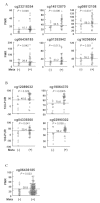Identification of a DNA methylation marker that detects the presence of lymph node metastases of gastric cancers
- PMID: 22844368
- PMCID: PMC3402728
- DOI: 10.3892/ol.2012.708
Identification of a DNA methylation marker that detects the presence of lymph node metastases of gastric cancers
Abstract
The accurate detection of the presence of lymph node metastases (LNM) of gastric cancers (GCs) is useful for the implementation of necessary and sufficient treatment, but current methods of detection are unsatisfactory. In the present study, we focused on DNA methylation markers since they have several advantages, including biological and chemical stability and informativeness even in the presence of contaminating cells. Using three metastatic lymph nodes and three primary GCs without LNM, methylation bead array analyses were performed, which enabled the interrogation of 485,577 CpG sites. A total of 31 CpG sites that were hypermethylated in the metastatic lymph nodes, compared with the GCs without LNM, were isolated. Using primary GCs with and without LNM (28 GCs with LNM and 10 without), their methylation levels were measured using quantitative PCR following treatment with sodium bisulfite or a methylation-sensitive restriction enzyme. Of the genomic regions around the 31 CpG sites, 10 regions demonstrated higher methylation levels in the GCs with LNM compared with the GCs without LNM (P<0.05). Finally, the hypermethylation of the 10 regions was validated using another set of samples (129 GCs with LNM and 20 without). Hypermethylation of the region around the cg06436185 CpG site predicted the presence of LNM at a sensitivity of 43% and specificity of 85%. Additionally, the hypermethylation of the region was associated with a poor survival rate among GC patients with LNM. The results of the present study indicated that the methylation status of the region was a promising candidate marker to detect the presence of LNM of GCs and may reflect the malignant potential of GCs.
Figures



Similar articles
-
Diagnostic Accuracy of Ga-68-HBED-CC-PSMA-Ligand-PET/CT before Salvage Lymph Node Dissection for Recurrent Prostate Cancer.Theranostics. 2017 Apr 10;7(6):1770-1780. doi: 10.7150/thno.18421. eCollection 2017. Theranostics. 2017. PMID: 28529650 Free PMC article.
-
Analysis of the clinical significance of DNA methylation in gastric cancer based on a genome-wide high-resolution array.Clin Epigenetics. 2019 Nov 1;11(1):154. doi: 10.1186/s13148-019-0747-5. Clin Epigenetics. 2019. PMID: 31675985 Free PMC article.
-
Prospective Study of CRMP4 Promoter Methylation in Prostate Biopsies as a Predictor For Lymph Node Metastases.J Natl Cancer Inst. 2017 Jan 25;109(6). doi: 10.1093/jnci/djw282. Print 2017 Jan. J Natl Cancer Inst. 2017. PMID: 28122909
-
Genome-wide screening of DNA methylation associated with lymph node metastasis in esophageal squamous cell carcinoma.Oncotarget. 2017 Jun 6;8(23):37740-37750. doi: 10.18632/oncotarget.17147. Oncotarget. 2017. PMID: 28465481 Free PMC article.
-
Current Imaging Techniques for Lymph Node Staging in Prostate Cancer: A Review.Front Surg. 2018 Dec 7;5:74. doi: 10.3389/fsurg.2018.00074. eCollection 2018. Front Surg. 2018. PMID: 30581819 Free PMC article. Review.
Cited by
-
DNA methylation marker to estimate the breast cancer cell fraction in DNA samples.Med Oncol. 2018 Sep 14;35(11):147. doi: 10.1007/s12032-018-1207-3. Med Oncol. 2018. PMID: 30218172 Clinical Trial.
-
CDKN2A Deletion Leading to Hematogenous Metastasis of Human Gastric Carcinoma.Front Oncol. 2021 Dec 23;11:801219. doi: 10.3389/fonc.2021.801219. eCollection 2021. Front Oncol. 2021. PMID: 35004325 Free PMC article.
-
Integrated analysis of cancer-related pathways affected by genetic and epigenetic alterations in gastric cancer.Gastric Cancer. 2015 Jan;18(1):65-76. doi: 10.1007/s10120-014-0348-0. Epub 2014 Feb 9. Gastric Cancer. 2015. PMID: 24510342
-
A panel of DNA methylated markers predicts metastasis of pN0M0 gastric carcinoma: a prospective cohort study.Br J Cancer. 2019 Oct;121(7):529-536. doi: 10.1038/s41416-019-0552-0. Epub 2019 Aug 21. Br J Cancer. 2019. PMID: 31431673 Free PMC article.
-
ZNF695 methylation predicts a response of esophageal squamous cell carcinoma to definitive chemoradiotherapy.J Cancer Res Clin Oncol. 2015 Mar;141(3):453-63. doi: 10.1007/s00432-014-1841-x. Epub 2014 Oct 2. J Cancer Res Clin Oncol. 2015. PMID: 25273507
References
-
- Matsuda A, Matsuda T. Time trends in stomach cancer mortality (1950–2008) in Japan, the USA and Europe based on the WHO mortality database. Jpn J Clin Oncol. 2011;41:932–933. - PubMed
-
- Kamangar F, Dores GM, Anderson WF. Patterns of cancer incidence, mortality, and prevalence across five continents: defining priorities to reduce cancer disparities in different geographic regions of the world. J Clin Oncol. 2006;24:2137–2150. - PubMed
-
- Yokota T, Ishiyama S, Saito T, et al. Lymph node metastasis as a significant prognostic factor in gastric cancer: a multiple logistic regression analysis. Scand J Gastroenterol. 2004;39:380–384. - PubMed
-
- Chen JH, Wu CW, Lo SS, et al. Lymph node metastasis as a single predictor in patients with Borrmann type I gastric cancer. Hepatogastroenterology. 2007;54:981–984. - PubMed
-
- Saito H, Fukumoto Y, Osaki T, et al. Prognostic significance of level and number of lymph node metastases in patients with gastric cancer. Ann Surg Oncol. 2007;14:1688–1693. - PubMed
LinkOut - more resources
Full Text Sources
Miscellaneous
